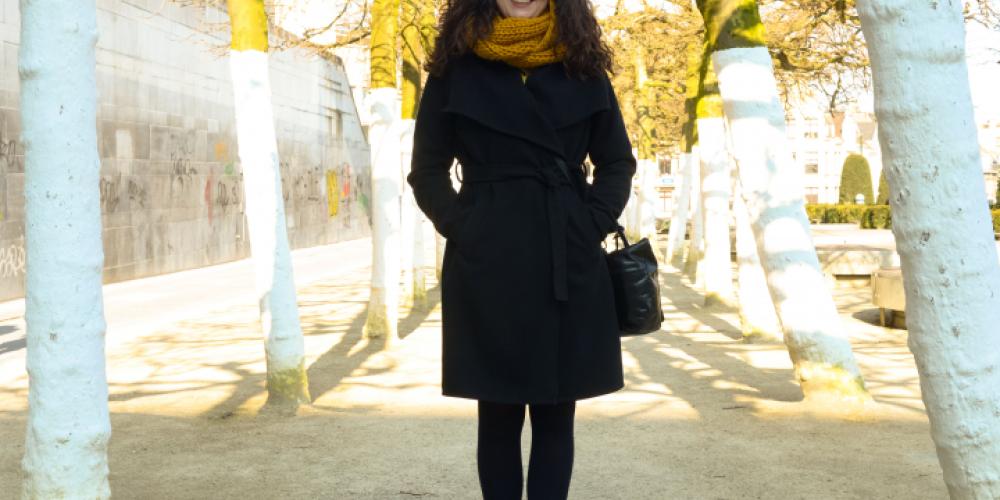
Museum district
“Central Station has always been my gateway to Brussels,” says Ann Dooms as she walks with us from the station towards the Kunstberg. “I’m a committed user of public transport. I started commuting as a student in 1995, shuttling to and from VUB. But instead of taking the train to Etterbeek, I walk up the Kunstberg.
“There’s a real park atmosphere here with the benches, trees and statues. It’s a calm place in a city that’s constantly on the move. There are many gems in the park: sculptures, the clock and the glass cube of Square – and the Royal Library. I usually take this route from the centre, walk up the Kunstberg, by the Musical Instruments Museum, the Magritte Museum, the Belvue Museum, and then past the Royal Palace and the Academy Palace towards Troon, where I catch the 95 bus to VUB. Previously, like so many colleagues in the pre-digital era, I’d stop off at the FWO research foundation in Egmontstraat to hand in a research request.
“For a change of scene I sometimes take the route behind the Ravenstein Gallery, alongside Bozar, up the steps and through the Warandepark. This route offers more greenery, plus the Art Nouveau/Art Deco atmosphere the neighbourhood exudes. I find the walking option more appealing than just taking the train from Central to Etterbeek. When I’m with colleagues from overseas I always take them on a long stroll through the city. At those times, this area is a mandatory stop.”
As the bells of the Kunstberg carillon begin to peal, she says the clock is definitely another essential sight for visitors. “My son will stand, hypnotised, watching the moving figures. Although, to be honest, the whole thing is bigger in my head than it is in reality,” she says, laughing.
The road up the Kunstberg can best be described as tough. “Sometimes it leaves me a bit out of breath, but it gives you a spellbinding view of the city centre when you look back from the fountain.
“Not many people know that three auditoria, with a total surface area of 10,000m2, are tucked away under the Kunstberg. The Congress Palace was built at the time of the ’58 Expo and you can find original 1960s murals by Magritte and Delvaux here. In 2011, I organised the IEEE International Conference on Image Processing here at Square; it won a Visit Brussels Award.”
Dooms also hung out around here as a student. “In the pre-mobile phone era the Kunstberg steps were the meeting place. I often went to Cinematek, just around the corner. And I cherish some great memories of Museum Night Fever in Bozar.”
The Kunstberg is a calm place in a city that's constantly on the move.
Maths and art
A mathematician in the midst of one of the great cultural spots of Brussels? “There are more connections than you would think,” says Dooms, who leads DIWS, a digital mathematics research group within the department of mathematics. “I’m someone who is wide open to the applications of maths in other disciplines – culture, in this case. Maths is not only about solving complex integrals. For example, Ingrid Daubechies, my colleague and a VUB alumna, is world renowned for her wavelets, used for image compression. She also applies this technique to research the authenticity of works of art – it was initially used on Van Gogh paintings. At the eponymous museum in Amsterdam they still have questions about some paintings. The Royal Museums of Fine Arts of Belgium (KMSK) were aghast when we proposed surveying their collections because, of course, all the artworks there are genuine. At the KMSK the emphasis is mainly on conservation, so we’ve made the move towards applying digital mathematical techniques to the conservation and restoration of our cultural heritage.”
B-spot becomes a workplace
As well as being her favourite place, the Kunstberg has increasingly become Dooms’s workplace. In addition to working with the KMSK, from September she will regularly spend time working on the collection of the Royal Library of Belgium. With external partners ULB and CegeSoma, she will develop an automatic quality control process for scanned newspapers and photographs.
Her professional life brings her to the immediate area neighbouring the Kunstberg. And so, at the end of our stroll, we pass through Museumplein to the other side of the Warandepark, to the Academy Palace, next to the Royal Palace. Here, Dooms is a member of the Young Academy, an independent body for top young researchers and artists with its own take on policy, society, research and art.
The days of just passing through are gone; Dooms has now arrived.